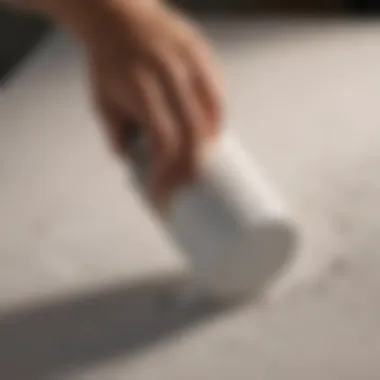Benefits and Techniques for Small Foam Rollers in Painting


Intro
Overview of Topic
Using small foam rollers in paint application has garnered attention within the home improvement industry. These tools offer one of the easiest methods for applying paint to various surfaces—be it walls, furniture, or crafts. Unlike traditional brushes, foam rollers can provide a smooth and consistent finish, reducing the chances of streaking or uneven coats. This is particularly relevant as homeowners increasingly seek efficient yet high-quality results for their DIY projects.
The rising popularity of these rollers stems from their simplicity and versatility. Small foam rollers can easily tackle tight spaces, corners, and even detailed embellishments where standard equipment might fall short. The significance of adapting contemporary practices in interior decor can not be underestimated; the aesthetics of home spaces is ultimately influenced by painting techniques employed by homeowners. Hence, small foam rollers serve a dual purpose—not only do they aid in achieving great results, but they also empower homeowners to express their creativity.
Common Challenges and Solutions
Every DIY endeavor comes with its challenges. When working with small foam rollers, homeowners often encounter issues such as limited coverage, excessive bubbling, or even roller marks. Additionally, cleaning and maintaining these tools demands attention, with improper care potentially leading to subpar results.
To counter these challenges, consider the following tips:
- Select the right foam roller: Different foam types suit various surfaces. For instance, choose a denser foam for smooth finishes, while a looser foam works better on textured surfaces.
- Test techniques: Before applying paint to the whole area, conduct a patch test to determine how the roller handles your chosen paint type and surface.
- Use proper rolling motion: A consistent back-and-forth or up-and-down motion will yield the best results, minimizing bubbles and lines.
- Cleaning after use: Immediately rinsing foam rollers after use enhances their lifespan. Store them properly to prevent drying out.
Proper technique can drastically improve results, ensuring that your efforts enhance the aesthetics of your home.
Product Recommendations
Evaluating the right tools is integral to successful paint projects. Here are some top-rated products in the market:
- Pro Grade - Paint Roller Covers: Known for their durability and dense foam, they work efficiently on different surfaces, yielding smooth results.
- Foam Pro - Foam Roller: This option provides excellent coverage and minimizes splatter. Its soft design suits water-based paints brilliantly.
- Purdy - Heavy-Duty Roller Frame: While not a foam product, it goes well with foam roller covers, providing exceptional support during application.
Each choice offers unique benefits that contribute positively to the quality of the paint application process. Practical features in these products set them apart, permitting both novice and expert homeowners the ability to achieve high standards without much hassle.
Step-by-Step Guides
Getting the most out of small foam rollers requires following a methodical approach. Here’s a step-by-step guide to maximizing their use:
- Prepare your workspace: Lay out drop cloths to protect surfaces from paint splatter. Remove any furniture that might obstruct the process.
- Select the paint and roller: Based on the earlier insights, choose the appropriate foam roller for your task. Make sure the paint is well-mixed.
- Apply primer if necessary: For best results, priming the surface should precede paint application. Use a small foam roller for the primer to keep it uniform.
- Start rolling: Dip the foam roller in paint, removing excess to avoid dripping. Apply consistent pressure as you roll, overlapping sections lightly.
- Allow to dry: After the first coat, give it adequate time to dry before applying additional layers. Consider the type of paint used for accurate drying times.
- Finish: Inspect your work for touch-ups after drying. Clean your roller according to manufacturer instructions.
Following these steps can effectively streamline the paint application process, making the use of foam rollers an overall beneficial choice for homeowners.
Intro to Small Foam Rollers
Small foam rollers have gained attention in the painiting industry due to their practical applications and efficiency. This topic is central to understanding modern painting methods. By examining foam rollers, readers learn how these tools create smooth finishes, enhance usability, and offer versatility over traditional tools.
Definition and Purpose
Small foam rollers are tools designed for applying paint with greater precision and control. Unlike larger rollers, these small variants offer unique handling characteristics. Their primary purpose is to deliver a uniform coat while minimizing excess paint and reducing splatter. Many both professionals and DIYers value this agility in tightening spots or smaller surfaces.
Types of Foam Rollers
Different kinds of foam rollers exist, each 为ing特色 benefits and drawbacks suited for distinct projects.
Standard Foam Rollers
Standard foam rollers are widely used as an effective solution. They have a smooth surface that helps in achieving a consistent finish. Additionally, they roll on walls or ceilings with ease, requiring simple techniques for various paint kinds. One key characteristic is their absorbency, which ensures an even application. Despite doing well with water-based paints, they may struggle with thicker coatings.
Micro-Foam Rollers
Micro-foam rollers excel in producing an even finer finish compared to the standard versions. Their smaller size allows for intricate detail work, making them advantageous for moldings and trims. The unique feature is their ability to handle meticulous tasks without leaving unsightly roller marks. They are a popular choice when delicate work is needed, but they might not cover large areas efficiently, requiring more time.


Specialized Foam Rollers
Specialized foam rollers offer specific designs for unique tasks. They are tailored for textured surfaces or particular paint types like varnishes or adhesives. The variability in roller material focuses on delivering targeted performance. Although they can bring about perfect finishes for those specialized tasks, using them in improper situations may lead to less-than-ideal results. Awareness of the project types and surfaces is essential when choosing these tools.
Advantages of Using Small Foam Rollers
Small foam rollers are becoming increasingly popular tools for paint application, with a range of benefits that cater to both professional painters and homeowners. These advantages support a more effective and efficient painting process, which ultimately makes the experience more enjoyable. Understanding these benefits can significantly influence the choice of tools when planning a painting project.
Smooth Finish
One of the key advantages of small foam rollers is their ability to deliver a smooth finish. The unique texture of foam disperses paint evenly across the surface, minimizing the chances of drips or roller marks. This is particularly important for projects where the aesthetics of the final result are paramount. In achieving smoothness, small foam rollers excel on flat or semi-gloss surfaces, making them an optimal choice for such applications.
Moreover, with the right technique, users can attain a professional-grade look without the fuss. The lightweight nature of foam rollers makes control easy, ensuring that you can deftly navigate corners and edges without compromising the overall appearance. Therefore, achieving this quality finish elevates the likely impact of the completed work, whether it is a living room wall or a piece of furniture.
Ease of Use
Another prominent benefit of small foam rollers lies in their user-friendly design. They require minimal skill to operate effectively, making them accessible to individuals at all experience levels. For those hesitant about their painting abilities, using foam rollers can provide a sense of confidence and ease. The roller's ability to cover large areas quickly simplifies the overall painting process.
Key points to consider for ease of use:
- Foam rollers are lightweight and easy to maneuver.
- Painting can be done in a straightforward back-and-forth motion, reducing the need for complicated techniques.
- They possess the adaptability to be used on a variety of surfaces, allowing users to tackle different tasks with the same tool.
Individuals find it advantageous they do not need to apply an excessive amount of pressure to achieve even coverage. This factor further simplifies tasks such as edging and cutting in around trim, giving every DIYer a tool that minimizes struggle and maximizes joy in creation.
Versatility in Application
Versatility is a strong driving force behind the appeal of small foam rollers. These tools can be used for various painting needs, from applying primers to topcoats on walls or specialized finishes on furniture and crafts. Their ability to dispense diverse types of paints, including water-based and oil-based, allows for a wide array of projects throughout the home.
Some practical applications include:
- Decorative finishes: Small foam rollers are perfect for adding textures or patterns by using techniques such as sponging or stippling.
- Side projects: With their compact size, they handle tasks like painting smaller objects (i.e. shelves, picture frames) easily.
- User adaptability: Individuals can experiment with different paint types and techniques without needing to invest heavily in various brushes or other applications tools.
By fostering creativity and offering adaptability, small foam rollers become effective companions in any art or decor endeavor. All of these advantages contribute to elevating the painting experience, assisting users in achieving desired results with less pressure and complexity.
Using small foam rollers transforms the painting process, offering effective results while encouraging exploration in surface finishing.
Optimal Techniques for Painting with Foam Rollers
Optimizing the techniques for painting with foam rollers is essential for achieving satisfactory results in any painting project. Understanding these techniques can prevent common pitfalls and enhance the overall quality of the finish you accomplish. Knowledge about the right approaches contributes significantly to ensuring an even application of paint, maximizes the performance of the rollers, and minimizes the risk of mistakes, fostering a more enjoyable painting experience.
Preparation of Surface
Surface preparation is a critical step in the painting process. It lays the groundwork for the layers of paint, acting as the foundation for the whole project. Properly cleaned and primed surfaces can greatly enhance adhesion and durability of the paint. Moreover, addressing imperfections like cracks and holes ensures a smoother finish.
Before starting, ensure the surface is clean from dust, grease, and other contaminants. Depending on the surface type, this may involve washing, sanding, or filling gaps. Taking time to complete this task results in a more professional completed look and increases the paint's longevity.
Loading the Roller
Loading the roller properly is crucial for an even application of paint. This technique involves saturating the foam with paint so that it can smoothly transfer the color to the surface. First, dip your roller into the paint, then roll it on the tray's ridges to distribute the excess. This helps avoid excess dripping, which can make a mess.
If the roller is inadequately loaded, it may lead to uneven coverage and streaks. Conversely, overloading can result in drips and splashes. Following this technique not only lends to high-quality results but also fosters an efficient workflow during the painting process.
Rolling Techniques
Using a consistent pressure


Using a consistent pressure while rolling is fundamental to maintaining a uniform finish. This professional touch ensures that the paint is applied evenly across the surface without leaving marks or uneven patches. The goal is to apply pressure that is firm, yet gentle enough to allow the roller to glide smoothly. This seamless motion leads to minimal texture on the wall.
A key aspect of maintaining consistent pressure is the ability to control the motion without exerting too much force. The superiority of this technique lies in its repetitive nature. Achieving an even look can amplify the aesthetics of a space and bring a level of sophistication to any room or exterior.
Maintaining a wet edge
Maintaining a wet edge is an essential consideration as it contributes to an aesthetically pleasing finish. This technique involves overlapping each stroke before the last one dries. Wet edges prevent unsightly lines and uneven tones by ensuring the paint layers bond seamlessly.
The distinct feature of this method is its ability to substantially reduce visible seams. It often results in smooth finishes integral to professional work. However, it demands a well-organized working environment, ensuring that paint remains workable at all times. Negotiating between efficiency and quality through this technique truly reflects the standards expected in painting practices.
Maintaining a wet edge not only avoids imperfections but also enhances the depth of color, giving a project a polished look.
Overall, these techniques are imperative to mastering the use of small foam rollers in any painting task, ensuring that both amateurs and experts can achieve outstanding results.
Common Mistakes to Avoid
Understanding common mistakes in using small foam rollers is essential for anyone looking to achieve a flawless finish when painting. Even small oversights can lead to undesirable results, which may require rework or could undermine overall satisfaction with the project. Here are critical aspects to consider in order to avoid these pitfalls, ensuring a more effective paint application and an enjoyable experience overall.
Overloading the Roller
One frequent misstep when using small foam rollers is overloading the roller with paint. This mistake often leads to drips, uneven application, and texture issues on the surface. It may feel tempting to apply more paint in one go but doing so can compromise the finishing quality. Instead of focusing on loading the roller fully, it is better to apply an adequate amount, ensuring the foam absorbs the paint without saturating it. Ideally, the roller should be evenly coated, allowing for smooth distribution that enhances surface coverage. Moreover, rolling technique should allow for a consistent, controlled application which provides a precise finish.
Neglecting Surface Preparation
Surface preparation is a crucial element that cannot be overlooked. Before any paint touches the surface, ensuring it is clean, dry, and appropriately prepared is critical. Neglecting this step can lead to adhesion problems, affecting the longevity and overall appearance of the finished paint job. This may involve sanding down rough areas, filling in cracks, and cleaning surfaces free from dust or grease. Properly preparing a surface not only facilitates better paint adherence but also minimizes chances of defects such as bubbling and peeling. Therefore,house owners should invest time in meticulous surface prep prior to commencement with foam rollers.
Failure to Clean Properly
Lastly, one significant mistake is failing to clean foam rollers properly after use. This can lead to hardened paint remaining in the fibers, which diminishes the roller's effectiveness for future jobs. Cleaning rollers should be approached with due diligence; the choice of cleaning solution and method should align with whether the paint used is water-based or oil-based. For oil-based paint, solvents like mineral spirits work best, while warm soapy water suffices for water-based options. Properly cleaning rollers contributes not just to their longevity but also to the quality of subsequent paint applications.
To retain optimal performance of small foam rollers, always incorporate effective cleaning routines after every application session.
Achieving desired results with small foam rollers requires being vigilant about common mistakes. Recognizing issues like overloading, improper surface preparation, and neglecting roller maintenance can greatly enhance the painting process. Addressing these mistakes encourages a rewarding painting experience and results in visual satisfaction within the project.
Environmental Considerations
Understanding environmental considerations in paint application is vital. Traditional painting tools and processes may lead to significant waste and harmful emissions. Small foam rollers present several advantages, reducing these negative impacts while still achieving satisfactory results. Industries and homeowners alike aim to lower their carbon footprint. Choosing more sustainable painting methods is a critical step in that journey.
Sustainability of Foam Rollers
Sustainability in the context of small foam rollers refers to their manufacturing, usage, and disposal phases. Foam rollers, made from materials like polyurethane, have seen advancements in their production processes. Many manufacturers now prioritize eco-friendlier practices.
The longevity of foam rollers also promotes sustainability. Proper care allows them to be reused multiple times, minimizing resource consumption. It is crucial for users to select rollers designed for durability rather than opting for instantly cheaper alternatives. This choice can ultimately contribute to a more sustainable painting environment.
Moreover, some brands have emerged that focus specifically on producing eco-friendly foam rollers. For example, choosing products made from recycled materials or biodegradable options can significantly offset your carbon footprint compared to traditional options.
Disposal Options
Disposing of small foam rollers requires awareness, as improper disposal methods can harm the environment. Here are recommendations for responsibly disposing of foam rollers:
- Reuse: If the rollers are still in good condition, consider repurposing them for different painting projects or other crafts.
- Recycling: Look for local recycling programs that accept foam materials. While not every area recycles foam, some specialized facilities do.
- Landfill: If reuse and recycling aren’t possible, responsibly placing them in a landfill is sometimes necessary. Always check local regulations for proper disposal methods to prevent harm to wildlife.
In the interest of the planet, investing in sustainable practices isn't just a choice, it is a responsibility.


Considering these environmental aspects when using small foam rollers at home minimizes ecological impact. Through conscious selection, usage, and disposal, one can contribute to a healthier planet while achieving satisfactory painting results.
Maintenance and Care of Small Foam Rollers
The longevity and function of small foam rollers significantly depend on how well they are maintained. Proper maintenance ensures that their performance remains optimal throughout their use. Neglecting care can lead to reduced painting quality or even the need to replace rollers far more frequently than necessary. Thus, knowing how to clean and store these tools can extend their lifespan and improve overall efficiency during paint application.
Cleaning Techniques
Cleaning foam rollers is essential after every use. Paint residue, if left unaddressed, can ruin the texture of the foam and make future applications uneven. Here are some effective cleaning techniques:
- Water-Based Paints: If the paint used is water-based, rinse the roller under warm, running water first. Roll it back and forth in some water until the paint washes away.
- Oil-Based Paints: For oil-based paints, use the appropriate solvent, like mineral spirits. Soak the foam roller for a few minutes, then use a brush to gently remove residual paint.
- Thumb Method: For any stubborn areas, use your thumb to press against the sponge while cleaning, other rolling it on scrap material. This helps push paint out trapped inside the foam.
Make sure to remove paint from the inner roller core as well, as dried paint buildup can affect the roller's functioning over time.
Storage Guidelines
Proper storage of small foam rollers is equally important for ensuring they stay in good shape between uses. Here are guidelines to follow:
- Clean Before Storing: Always clean the roller, as mentioned earlier, before putting it away. If it is stored while still covered in paint, it can harden and become unuseable.
- Flat Area: Store the roller flat rather than standing up. This prevents the foam from bending and losing its shape.
- Protective Cover: Use a plastic bag or wrapping when storing. This will keep dust and debris away, ensuring that the surface remains smooth for future applications.
- Cool Location: Choose a storage location that is away from humidity and extreme temperatures. High heat can warp the foam, affecting the setup might performance during next paint job.
Properly maintained small foam rollers not only enhance your painting outcome but also save you time and money in the long run by minimizing the need to replace tools wasted through poor care.
By incorporating these cleaning techniques and storage guidelines into your routine, the benefits of using small foam rollers can be optimized, leading to both satisfaction and quality in your painting projects.
Comparative Analysis with Other Painting Tools
Understanding various painting tools is essential in determining the right approach for your project. A comparative analysis highlights the distinct features and usability of small foam rollers relative to other painting implements. By examining these differences, one can make informed choices that align with both the intended results and the context of the task.
Foam Rollers vs.
Brushes
Small foam rollers and brushes are two common tools, each with their own strengths and weaknesses. Foam rollers offer a smoother finish with less visible brush strokes, which is particularly beneficial for larger flat surfaces. Their design allows them to hold a large amount of paint, leading to efficient coverage of walls or ceilings, while brushes excel in applying paint to intricate or textured areas.
However, brushes can often leave streaks or lap lines when not used properly, making foam rollers a preferable option for beginners or those looking for perfection in their finishes. On the other hand, a good brush provides control in narrow spaces or corners, which foam rollers sometimes struggle to Reach.
In summary, the choice between foam rollers and brushes depends largely on the specific demands of the project.
Foam Rollers vs.
Sprayers
When compared to paint sprayers, small foam rollers provide different user experiences and effectiveness, depending on the project’s scale and purpose. Foam rollers are more suited for smaller jobs or touch-ups, while sprayers can handle larger areas rapidly. This quick application is ideal for achieving a uniform coat but requires careful masking and preparation to avoid overspray.
Additionally, foam rollers are much simpler to operate, making them user-friendly for novices. They avoid the mess that often accompanies sprayers, where paint can end up in unwanted places. The cleanup for foam rollers is relatively straightforward, while sprayers require thorough cleaning of components and equipment.
While sprayers do offer a sleek finish and time efficiency for extensive surface applications, the skill level and additional preparation often needed may not appeal to an average DIY home project.
Closure
The conclusion of this article recaps the crucial aspects of using small foam rollers in paint application. It underscores how these tools have revolutionized the processes for both seasoned painters and novices. One main benefit is the ability for individuals to achieve a smooth, professional finish with relative ease. Furthermore, with proper techniques and care, small foam rollers can drastically improve efficiency and produce results that rival traditional methods, ultimately elevating the final appearance of painted surfaces.
Summary of Key Points
- Types of Foam Rollers: Small foam rollers come in various types like Standard and Micro-Foam, offering choices for different applications.
- Advantages: Smooth finish, ease of use, and versatility are prime reasons why these tools are favored over others.
- Techniques: Proper surface preparation and rolling techniques enhance paint application quality. Neglecting fundamentals leads to predictable mistakes.
- Environmental Considerations: Foam roller sustainability and disposal options matter to environmentally-conscious users. Being informed assists in responsible choices.
- Maintenance: Regular cleaning and storage can prolong the life of foam rollers, thus making them a reliable tool through various projects.
Future of Foam Rollers in Painting
The future of foam rollers looks promising, as ongoing advancements in materials and design are expected. Research and innovation could lead to even more efficient applications, with foam rollers capable of handling more textures and finishes. As sustainability grows in importance, manufacturers might develop biodegradable options or ones made from recycled elements. Moreover, the embrace of technology, like roll 발송 알림 systems, could envelope more user feedback into new roller designs. Thus, small foam rollers are likely not just tools; they may transform as essential accessories for DIY painting and professional applications.
"With small foam rollers, the age of effortless painting has dawned."







